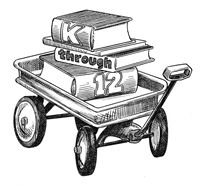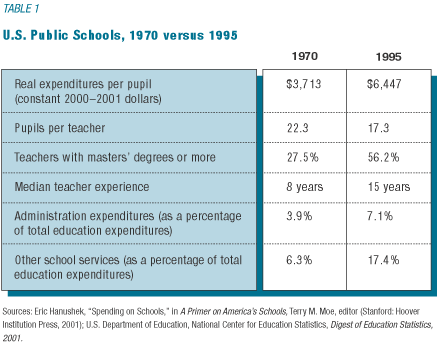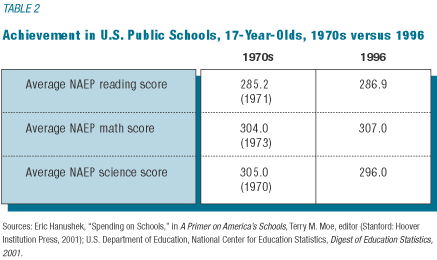- Education
- K-12

There is a common perception that the way to improve our failing public schools is to spend more money on them. According to many public school administrators, the amount we spend per pupil is an excellent way to affect student performance. Yet a review of the data over the past 80 years shows that this is not necessarily the case. In fact, increases in per-pupil expenditures in the past have often not been matched by increased student performance. In short, the evidence suggests that we cannot simply buy better schools.
Spending per student has increased markedly over time. According to the U.S. Department of Education, in the 1919–20 school year, expenditures per pupil (in constant 2000–2001 dollars) were $367. By 1960, real expenditures had more than quintupled. In the 2000–2001 school year, per-pupil expenditures were approximately $7,000—nearly 20 times as high as in the 1919–20 school year.
Where have the resources gone and what are the results? Special education is often cited as a primary contributor to increased per-pupil costs. Although special education has grown rapidly in recent years (approximately 13 percent of students are now designated as special-education students) and per-pupil expenditures for special education are more than twice the cost of regular education, such growth still does not account for the bulk of school spending. Cost data on special education are difficult to track, but according to recent estimates, special-education student expenditures accounted for less than 20 percent of expenditure growth between 1980 and 1990.
Three additional factors have contributed to increased expenditures: (1) falling pupil-teacher ratios (i.e., more teachers); (2) rising teacher salaries; and (3) growth in expenditures for things other than instructional salaries.
Between 1970 and 1995, per-pupil expenditures increased by more than 75 percent. During that time period, the pupil-teacher ratio decreased by 25 percent, the percentage of teachers with advanced degrees doubled, and median teacher experience nearly doubled. With more teachers in the system, and with teacher pay linked to increases in credentials and experience, higher per-pupil spending resulted. Furthermore, between the 1969–70 and 1995–96 school years, “administration expenditures” increased by more than 80 percent and “other school services” accounted for nearly 18 percent of total public education expenditures, an increase of almost 200 percent (see table 1).
More teachers with advanced degrees and more experience, and more teachers per student, should lead to better educational outcomes. The evidence, however, does not support that conclusion. During the same quarter-century that these educational resources were being increased, student achievement remained flat, as measured by the National Assessment of Educational Progress (NAEP) (see table 2).
The contradiction of increased resources and flat achievement suggests that resource shortages may not be the sole culprit for low levels of student performance. This is not to say that resources do not matter but that there is no simple cause-and-effect relationship.
Recent studies reinforce the disconnect between spending and achievement. For example, the American Legislative Exchange Council’s (ALEC) “Report Card on American Education, a State-by-State Analysis 1976– 2000” concluded that “it is clear after studying the data and results that the policies of the past have failed to meet the educational needs of our country’s children. If we continue to spend more money on the existing educational system in an attempt to buy our way to better student achievement, we will condemn another generation of students to mediocrity.” The ALEC study showed no correlation between conventional measures of educational inputs (such as expenditures per pupil and teacher salaries) and educational outputs (such as scores on standardized tests). Simply stated, increased funding does not translate into improved achievement.
An analysis of per-pupil expenditures on a state-by-state basis is illuminating. For example, in the 1998–99 school year, Utah spent $3,807 per pupil whereas Maryland spent $7,059. There is little evidence to suggest that equalizing resources between the two states would equalize achievement. In the 1998 NAEP, 31 percent of eighth graders in both Utah and Maryland scored at proficient or better in reading, despite the large discrepancy in per-pupil expenditures. Also, based on several standardized tests, the ALEC report rated Iowa (ranked 32d in per-pupil expenditures) as having the top-performing public elementary and secondary schools in the nation, followed by Minnesota (14th in spending) and Wisconsin (9th). At the bottom of the achievement ratings were Mississippi (50th in spending), the District of Columbia (5th), and Louisiana (39th).
Expenditures per student have increased over time, and the distribution of the expenditures has been according to popular emphasis: The level of teacher education has increased, teacher experience has increased, and student-teacher ratios have fallen. But the desired outcome—student achievement—has remained flat.
If increased resources are not at the heart of improved student achievement, what is? One possible answer is that resources need to be allocated differently rather than simply increased. For example, the present teacher pay system provides no way to distinguish between a good teacher and a bad teacher. Both can expect the same salary and promotion pattern, regardless of the performance of their students. The evidence suggests that resources are not the sole solution to poor student achievement; that financial incentives for teachers may be their necessary partner.









